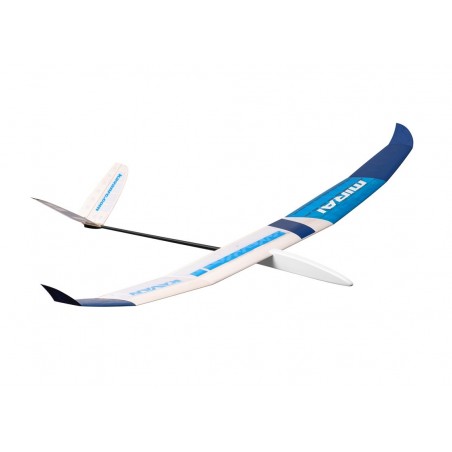
































The two-meter thermal glider is one of the most graceful models in the recreational modeller's hangar - nothing compares to leisurely relaxation flights in mild conditions, circling in thermals under the clouds, quietly flying in peace where you can sit and watch, your elegant model flies almost alone ... Currently, additionally, "two meters" with controlled rudder, height and an air brake starting with an "rubber" have their own special competition category, in which it is not only about the result, but about flying together with similarly experienced modelers. There is also an F5-RES category for two-meter electric sailplanes. Basically, it is the same model, differing only in the changes needed to place the engine and the propulsion battery in the hull, and in this set the hull is prepared for the construction of the selected electric or sailplane version.
The "two-meter model" is perfect for anyone who wants to build models on their own, in the classic way from balsa, plywood and spruce beams. The construction is quite fast and not too complicated - MIRAI V is quite simple model in terms of construction, but it is not intended for complete beginners because it requires some experience. Certainly, however, it can be built by a beginner modeler under the supervision of a modeling instructor, the more that many elements are cut with the use of CNC and do not require a large amount of work, but it can certainly be a bridge between recreating with an epp model and flying in competitions, or improving skills using a structural model. These types of models fly much better than foam models, and also offer a chance
The MIRAI V model was designed and manufactured in the Czech Republic, where aerial modeling is very popular and carried out during school activities.
A thermal glider set with a classic very light construction made entirely of balsa l, which can also be easily adapted to the drive of a 150-200W AC motor. MIRAI V is the perfect project for modellers who want to build a really powerful model for competitive or recreational flying. Thanks to the well thought-out design with CNC cut parts, featuring tabs and notches that fit like pieces of a puzzle, construction is very quick and easy. MIRAI V is a "top design", thanks to which you can successfully compete for places "on the box" in the F3-RES or F5-RES category. The kit includes fuselage parts in two electro and glider versions, and it depends on the assembler which version he will choose.
The front of the fuselage consists of a gondola made of balsa and light plywood, its core is a simple "box" structure with balsa sides and plywood frames. In the sailplane, the place for the rudder and elevator servos is located in the fuselage under a removable side cover with magnetic closure.
In the case of a powered sailplane, the servos are placed in the space under the wing. The tail of the fuselage consists of a beam made of carbon tubing with a glued pylon with a core of light plywood covered with balsa to protect the horizontal surface of the tail. The sailplane version also offers a carbon tube in the space under the wing, in which you can place additional ballast that will increase the range of conditions in which the model can be flown (stronger wind and gentle turbulence as well as sailing on a slope in light wind). Such solutions are available in high-performance glider models.
The three-part wing with a special HB RES profile is a classic structure with balsa ribs with a caisson, partially covered with balsa to achieve the required stiffness. Ears with elegant winglets are connected to the middle plane with carbon connectors and beech dowels and magnets for convenience, which ensures connection without the need for tapes or other solutions .. In the middle plane there is a two-part, tilting flap as an air brake, we advise you not to miss it, because it significantly facilitates lowering a strong thermometer and safely reducing the height, as well as comfortably reduces the speed of the approach to landing and its length, especially when the model with such performance can be carried above the ground for several meters. It is controlled by a single servo by a torsion drive made of a carbon rod with laminate levers. The wing is attached to the fuselage with a plastic screw, which is an easy and safe solution, and at the same time very aesthetic.
The model can be covered with foil - e.g. transparentOracoverI'm for purely recreational flying; if you are building a machine for competition, the lighter Oralite materials are preferred, or Japanese paper, it also saves some weight. It is worth thinking about it, because in such constructions the weight is important and affects how the model flies, especially in very weak thermals. To control the model, you will need at least a three-channel RC set (even a two-channel is enough for a clean glider without brakes). The servos proposed by the manufacturer are 2 pcs, e.g.HitecHS-53 and 1 pcs HS-65MG or any with similar parameters 9-15 g micro servos with a moment of 1.5-2 kg.cm. Back-up: The four-cell NiMH AAA ENELOOP 800 mAh battery is ideal for powering the on-board electronics, but other solutions can be used depending on your needs.
To drive the electric version, you will need an electric motor with a power of 150-200 W AC with a diameter of 22 mm, a 20A regulator, eg KAVAN R-20B, and a 2S or 3S LiPo 450 mAh battery.
The kit includes CNC cut balsa and plywood elements, rigid balsa slats and boards, carbon tube tail beam, accessory kit, self-adhesive decal sheet, 1: 1 scale construction plan and instructions.
You should buy:
RC equipment (servos, battery, possibly a regulator and a motor for the electric version. Material for covering the model with adhesives, possibly a rubber haul for rubber starts.)
Technical data: